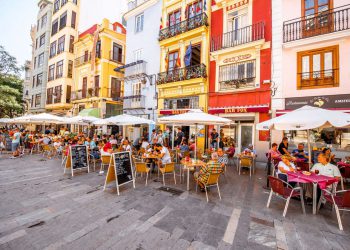[elementor-template id=”3753″]
This is dummy title and will be replaced with real title of your post
Image with size : 1140×570
Image: Getty Images
Spain is set to welcome the digital nomads within the most beautiful cities in the coming months.
“The digital nomad visa will attract and retain international and national talents by helping remote workers and digital nomads set up in Spain,” the Ministry of Economy has said.
Foreign nationals working remotely for non-Spanish enterprises will be able to live in the country without obtaining a complete work visa, thanks to the country’s recent Startup Act.
According to legal authorities, the draft law for the visa must now be sent to parliament, where it will require a majority vote to succeed. This might take till spring.
Once available, the visa is likely to allow people to stay between six and twelve months living and working in Spain without the right to residency, with up to two additional extensions granted if they match government-set requirements.
Since the Brexit transition period ended, the restrictions for staying in Spain have become stricter: Britons are only allowed to stay in Spain for 90 days without a visa in any 180-day period.
If you work as a freelancer, are employed full-time, or earn at least 80% of your income from companies outside of Spain, this could be a fantastic opportunity to live and work in our sunnier European neighbor – at least part-time.
So, which places from Spain will become the most popular vacation spots for digital nomads?
Madrid
For young professionals looking to hit the road, Spain’s answer to New York has an intuitive draw. It is one of the most interesting cities to live and work in Spain, with a cutting-edge cuisine culture, world-class shopping, beautiful rental apartments, and late-late nightlife. It’s also well connected to the rest of the country, with the snazzy high-speed AVE train taking less than two hours to the beach in Alicante on weekends.
Andalucia
Because of its southerly location and year-round pleasant weather, this rustic, olive-tree-studded region is a favorite. Furthermore, it boasts a plethora of charming fincas (zhushed-up farmhouses) to stay in, either as nomad-friendly guesthouses or as entire private rentals. The beautiful, ancient city center of Seville is an intriguing spot to decamp with your laptop; rental flats start at around £165 per night. But you’d be missing out if you didn’t venture out into the culinary, rustic-luxe countryside – for a rural treat with poolside breaks, try Finca Buenvino near Aracena or Cortijo del Marques near Granada.
Valencia
Because of its mix of urban entertainment and coastal relaxation, this city is becoming increasingly popular among Millennials. When you close your laptop, a large, sandy beach is edged with restaurants serving cool beers and paella, competing with hipster cafes and bars for the attention of the digital nomad population. It’s also less expensive to live in than Madrid or Barcelona, and it offers the most variety in terms of recreational opportunities, whether it’s in the city’s various green spaces or on the beaches of Costa Blanca.
Barcelona
Many people will, understandably, be drawn to Spain’s most popular tourist destination. In addition to its chic rental homes and nomad-friendly cafe culture, it is another beach-blessed metropolis with historic tapas cafes and bucket-list landmarks. However, it is more expensive than some other options, and as the cruise business recovers, you may expect a few cruise ships’ worths of passengers to arrive. The multinational population of Catalonia’s capital is a major allure; you’ll meet individuals from all over the world here (great for networking). A vibrant social environment can also help you blend in and learn the language: for a joyful, youthful neighborhood vibe, head to Poblenou or Gracia.
Source: msn.com
Related Posts
edit post

Relocation
The new remote working hotspots in Spain for digital nomads
edit post

Immigration
Registration for H-1B visas for the fiscal year 2023 will begin on March
edit post

HR
4 strategies for attracting and retaining young employees in the tech industry
edit post

Immigration
A tax-funded legal advice program for US immigrants
edit post

Immigration
Work Permit Requirements in Sweden and the Application Process
edit post

Immigration
